People
How Shantell Martin Turned Her Deceptively Childlike Drawings Into a Successful Multiplatform Business
The young London-born, New York-based artist is currently the subject of the first ever visual arts residency at 92nd Street Y.
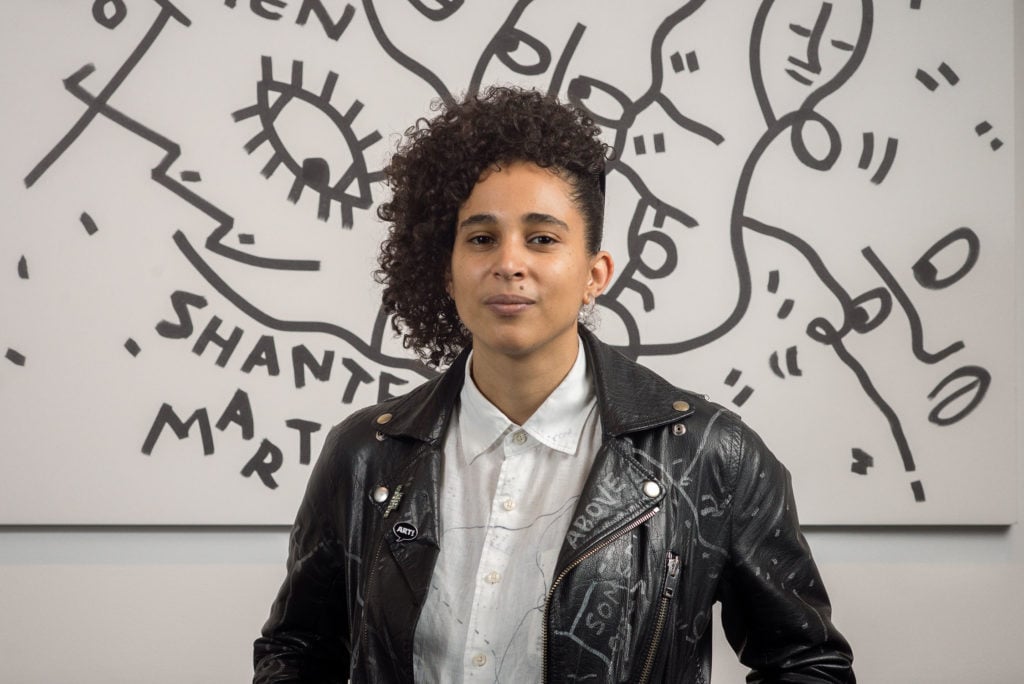
The young London-born, New York-based artist is currently the subject of the first ever visual arts residency at 92nd Street Y.

Taylor Dafoe

Even if you don’t know who Shantell Martin is, there’s a good chance you’d recognize her artwork. You might have seen it on the façade of a restaurant, the walls of a museum, or even on Instagram, where she’s amassed 160,000-plus followers. The London-born, New York-based artist’s style is unmistakable—words, stick figures, and curving, inky-black lines carve up white surfaces in form that exists somewhere between automatic art and minimalist illustration.
But these drawings don’t make up the whole of her practice. What makes Martin a budding art world star is all the unique way she incorporates her illustrations into other arenas: live drawing performances, VJ sets, inspirational workshops, and high-profile collaborations with fashion brands, shoe-makers, scientists, and even Kendrick Lamar.
Martin is currently the subject of a three-month long residency at Manhattan’s 92Y. A selection of new paintings, sculptures, and playful, site-specific interventions—all of which are rendered in her signature black-and-white style—are on view in an exhibition, “Shantell Martin: WHY NOW,” in the institution’s Milton J. Weill Art Gallery. She’s also participating in a number events throughout the residency’s run, including a workshop with New York City elementary students, a public talk with Broad City co-star (and self-proclaimed Martin fan) Illana Glazer, and a live performance, free to all, this weekend at the gallery.
This is the first residency offered to a visual artist at the 92Y—the first of many, according to Allison Valchius, the Director of the institution’s Art Center. For Valchius, Martin was the perfect artist to inaugurate this new initiative.
“I love that her art engages the viewer so viscerally. I felt that it could appeal to all ages, just as our institution’s programming does,” says Valchius. “Shantell is unusual because she welcomes showing the world her process. Most artists are not open to that type of interaction, but she embraces it, and uses that to encourage others to tap into their own creative impulses.”
Ahead of her first performance, artnet sat down with Martin at 92Y to talk about her work, her distinct trajectory as an artist, and the importance of collaboration.
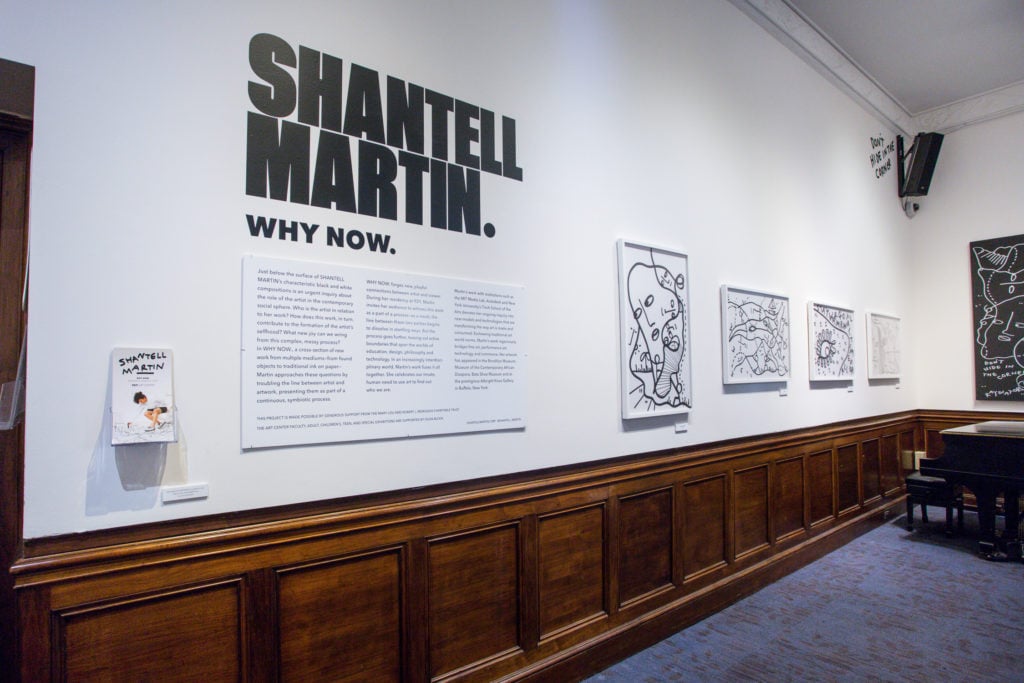
Installation view of “Shantell Martin: Why Now,” 2018. Courtesy of the 92nd St. Y. Photo: Michael Priest.
Can you tell me about your background and how you got into art?
I grew up in Thamesmead, a quiet, working-class place in Southeast London. My family is big. I have a bunch of brothers and sisters; there’s six of us altogether. We grew up with my mom.
I’m the only one in my family to ever finish school. I specialized in art, but I remember my teacher telling me that it’s probably better not to pursue it because I probably wouldn’t have a chance to get in to the art schools. When you’re young, if you don’t have any models of what you want to do around you, the only thing you’re going to do really is what people tell you not to do. My teacher told me I shouldn’t go to art school, so that’s what I applied for.
In 1999 I got into Camberwell College of Arts. It really opened up my world. I was meeting people from different backgrounds and experimenting with many different mediums. In a foundation course, you’re doing everything from sculpture to design to communications to printmaking to whatever.
After that, I applied to Central St. Martins and got in. I ended up graduating from Camberwell with distinction and Central St. Martins with first class honors. I studied graphic design, but realized pretty quickly that graphic design in the art world in England is pretty much all nepotism. Even though I had first class honors from this big fancy school, the jobs were going to people who had, say, an uncle at some agency. There was no real opportunity for me to do anything outside of the retail jobs that I had been working.
That’s when you moved to Japan?
Yes. When I graduated in 2003, I decided to leave and move to Japan. I had already been there twice at that point, visiting friends I had made at St. Martins. I was interested in Japanese culture, art, music, movies, animation. It just seemed like a nice, natural step to take six months or a year and teach English in Japan versus staying in England with this new pressure of “what will Shantell do now that she graduated at the top of her year?” I started my career in Japan and ended up staying there for 5 years.
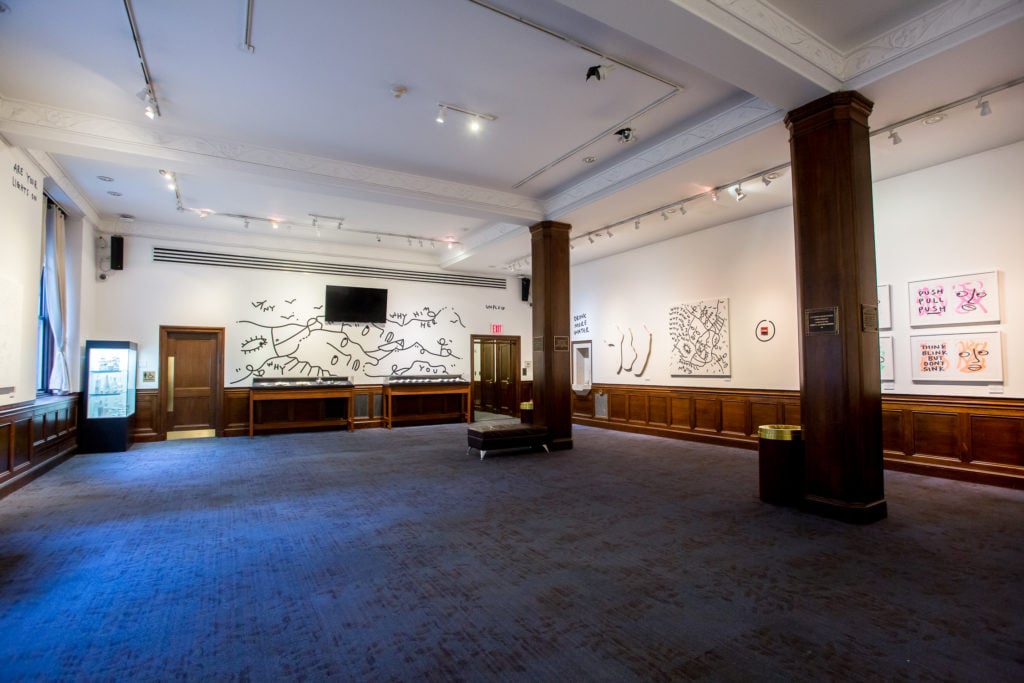
Installation view of “Shantell Martin: Why Now,” 2018. Courtesy of the 92nd St. Y. Photo: Michael Priest.
Why did you decide to move to New York?
I moved from Tokyo to New York in 2009. It’s a funny story. I met a lot of Americans in Japan and realized that they weren’t that bad. You know, in England, we have certain stereotypes about Americans. When you’re young, you believe those stereotypes. “Why would you want to go to America? They’re all loud and obnoxious.”
Of course I found that wasn’t the case. In Japan I met lots of Americans—people from Boston and New York and elsewhere—and they convinced me to come visit. So in 2008 I went for a holiday in New York. And just like anyone who goes for a holiday to New York, you think, “I love this place!” It’s the vitality, the strangers you talk to, the parties you go to. It was so different from the life I knew in Japan, and it just felt like there was so much opportunity and energy here.
In Japan you had made a name for yourself as a VJ, doing performative drawings during DJ sets. Were you still pursuing that when you moved to New York?
I tried to. Naively, I thought I’d just come to New York and pick up where I left off because it’s a big city, right? But it was such a hard sell, telling people, “Hey, I do these visuals—you set up a projector and I draw along to DJs, dancers, musicians.” People here just didn’t get it. So that basically crushed my career when I got here. I struggled with that for a long time. I ended up doing it a little bit here and there, but I struggled to find my feet for a long time. I de-evolved into drawing again with more traditional tools—with pens, with ink, with brushes.
At the same time, when I moved here, I was trying to work with galleries. I’m an artist, so that seemed like the most appropriate place to be. I would meet with gallerists and show them the very detailed work that I was working on at that time, and they would say, “Wow, we love this! Where have you shown?” And I would say, “Well, I haven’t. I came from the club scene of Japan.” And then it was “thank you but no thank you.”
I realized quite early on that there’s a catch 22—if you haven’t already shown, galleries won’t show you. So I thought, well, they’re not going to show my work, but of course I’m still going to make it because that’s what I do as an artist. I’m just going to have to find other avenues to get it out there.
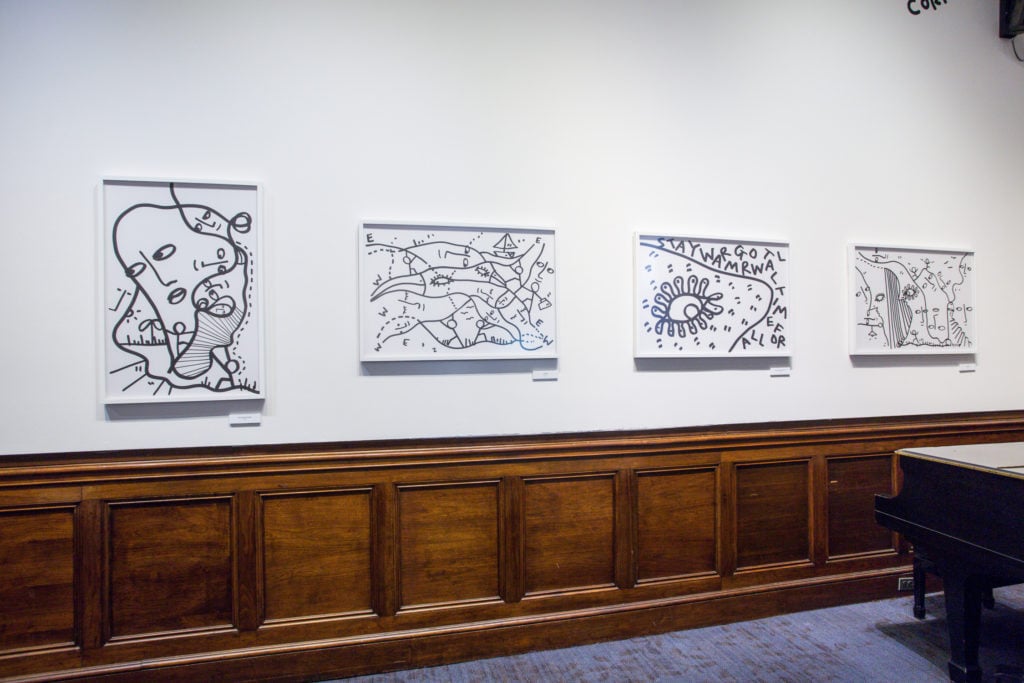
Installation view of “Shantell Martin: Why Now,” 2018. Courtesy of the 92nd St. Y. Photo: Michael Priest.
Collaboration is a big aspect of your practice.
Collaboration has always been an important tool for me. It came from being in Japan. My work as a VJ couldn’t exist without collaboration.
The same is true now too. The work that I’ve always wanted to do works best with collaboration. That’s my philosophy.
You also collaborate often with creatives outside your field—musicians, scientists, fashion designers. I imagine those diverse experiences have influenced your own work too.
Definitely. But on the other hand, you have people trying to be like, “Oh, but what are you? Are you a painter or an illustrator or a sculptor?”
For me, this goes back to being a kid who is mixed race, having people trying to say that I had to be this or I had to be that. I was like, “No, I can just be me.” Regardless of the medium, regardless of the industry, I’m going to do what I want. I’m going to collaborate with who I want. I’m going to say yes to projects that interest me.
So now I have a career where I’m opening a solo show at the Albright Knox gallery the same week that I’m launching a pair of sunglasses with Max Mara at Paris Fashion Week, where I’m in Vogue Paris in the same week that I’m at MIT media lab working on collaborative projects.
I think we can be a little bit naive in thinking, “You’re an artist—you shouldn’t be working with scientists or speaking at an engineering conference.” Why not? They’re as curious as we are; we’re all creative people trying to solve puzzles. My view has always been to say yes to projects that I’m curious about, that align morally and ethically with what I’m doing, that provide opportunities to grow and share something bigger than myself.
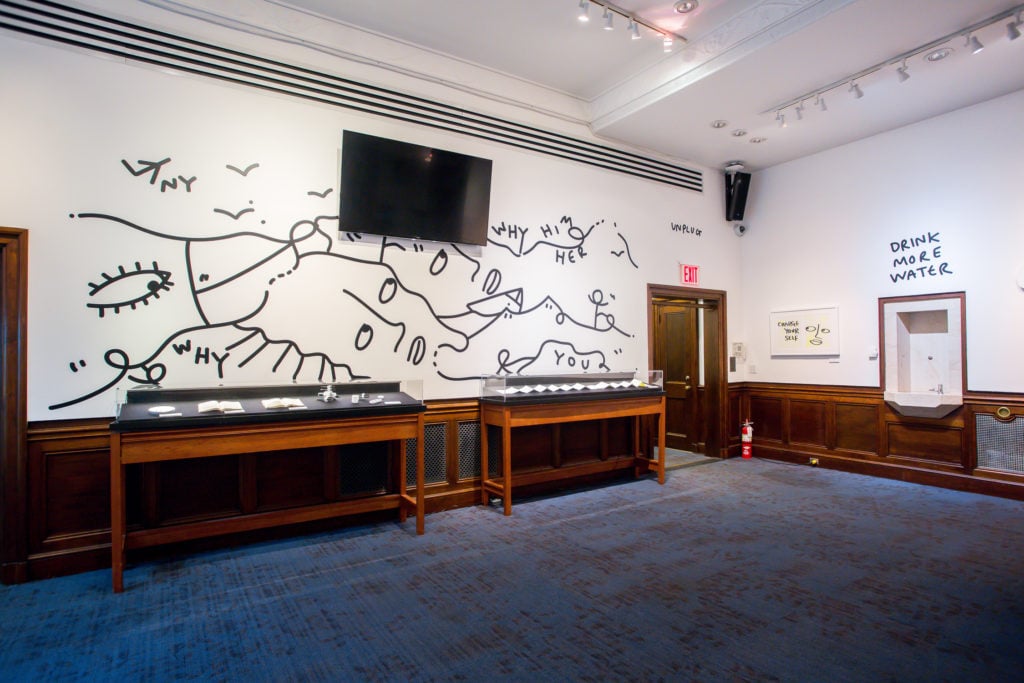
Installation view of “Shantell Martin: Why Now,” 2018. Courtesy of the 92nd St. Y. Photo: Michael Priest.
Sharing is an important part of your practice and message, and much of your success has come from utilizing all the platforms we have at our disposal today for sharing—Instagram, YouTube, and so on. When did you realize the potential of these resources?
It goes back to Japan. I would get tons of emails from people with random VJ questions, and I’d always reply. It’s the same today. Anyone who has ever messaged me has known that I’ve replied. I’ve built a community that way. That’s the most powerful resource.
I think a lot of people, especially artists, are scared to support other artists. I try to lead by example by always connecting other artists, trying to recommend them for projects as much as I can. Artists are so exploited that we need to come together and support and promote each other rather than competing.
What is it about the art world that fosters that sense of antagonism and competition? What can we do to subvert those tendencies?
It should be more transparent. We could talk for hours about the facade of the art space. At the end of the day, let’s just think about art as people creating things that other people observe and enjoy.
What we have now is a system with so many people in between these poles that the whole thing becomes confused. It takes power away from the artists. It’s a complicated system of commerce, except people pretend it’s not commerce.
For all the artists that say, “Oh no, I don’t want to talk about money”—either you’re privileged enough not to have to talk about money or you’ve been badly advised, because you should at least be knowledgeable about the financials of your life choice and career.
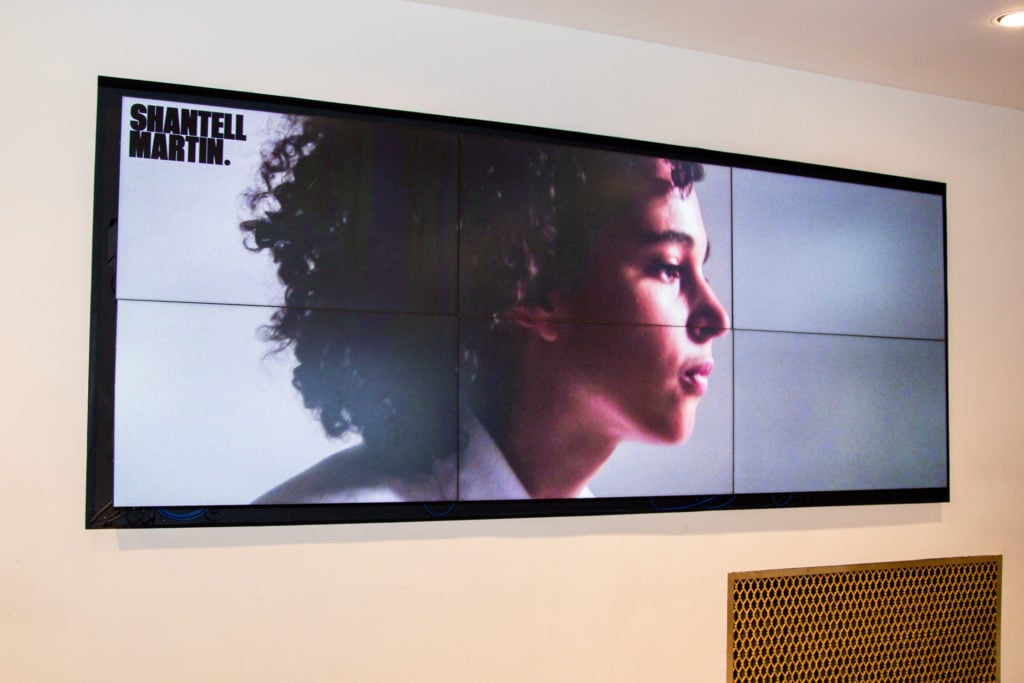
Installation view of “Shantell Martin: Why Now,” 2018. Courtesy of the 92nd St. Y. Photo: Michael Priest.
When you’re making work, be it alone or in public performance, are you thinking about what you’re doing—about composition and storytelling—or are you going into autopilot like, say, an athlete might?
It’s a mixture. There are two layers for me. The first is this spontaneous, intuitive layer—the autopilot layer, I guess. Below that is the foundation—it’s almost like an algorithmic way of making art.
If I’m alone or there’s an audience, I know that most of my drawing is going to start with a structure and a foundation—an initial line. Then, based on the language of the negative spaces that develop from that initial line, a sequence or a scenario unfolds.
So there is this foundational level of practice, of process, of understanding the building blocks of drawing, and then there’s the layer on top of it which is more improvisational and automatic. Going into a work, the things that are planned are the materials and the location and the tools I’m using.
As soon as I put the pen to the surface, then that system that I’ve developed starts to play out. I think this is the case for a lot of artists, especially ones that do line-based work—we give ourselves rules or limitations to work with.
Within your visual language, there are several repeating characters and figures. Can you give me a taxonomy of these figures and how they’ve evolved?
It’s like an orchestra, in a way—you have all these notes, all these recurring melodies. They’re related to places and people in my life, I think. Just as people in your life might be permanent fixtures, so are some of the characters within the work. Others might come and go.
There are the stick figures. Stick figures are very simple, something we all draw, and so it represents this idea that we can all participate in making art. At the same time, they also hold the structural integrity of the work together.
An older character I used to have, back when I was a teenager, was called Hangman. Hangman represented the urge to become more. But he had a noose around his neck, so he was part of the system.
I also have a bird boat. Wherever there’s an ocean, there’s often a boat and that boat is a bird. It represents being carried across challenges, or being able to take flight and soar above them. There are often different characters like that.
The larger faces that you see, they’re always looking to the left, as if they’re watching me as I draw them. They’re constantly in conversation with each other about life and identity and all these things that I think about in my work.
The faces only started appearing around 2014, but I can’t imagine my work right now without them. It’s funny, I’m looking around and a lot of characters that were in my work when I first moved to New York are no longer here.
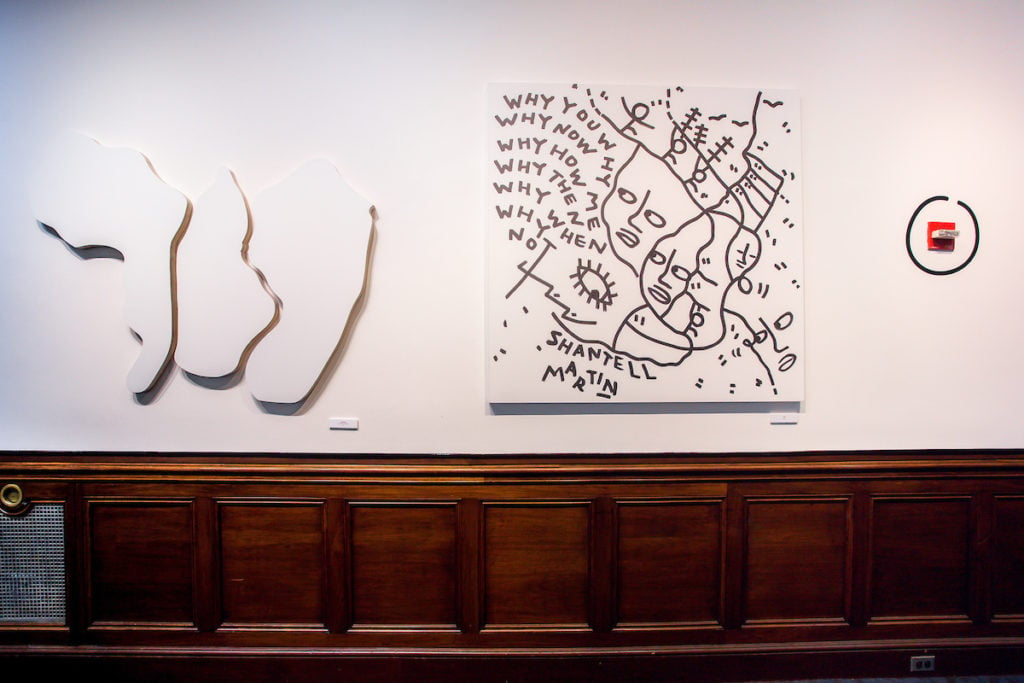
Installation view of “Shantell Martin: Why Now,” 2018. Courtesy of the 92nd St. Y. Photo: Michael Priest.
What about the phrase “WHO ARE YOU”? Those words and various iterations of them appear often in your work. What does that mean to you?
That’s always been there. I remember writing it on the back of my bedroom door for the first time writing that I was probably 13 or 14. I did the same thing when I moved to New York. That was probably around 2010.
I felt like I was in this position again of feeling completely lost because I didn’t have the career that I had in Japan and I didn’t have that fan base and I didn’t have a lot of friends here, so I was in a position where I had to find my way again.
If you write out “WHO ARE YOU,” you’ll see that the first three letters are W A Y. So essentially it’s about trying to find your way in life. About asking ourselves that question by posing it to the outside world.
“WHO ARE YOU” eventually turned into “YOU ARE YOU,” which is a destination. Then “YOU ARE YOU” became “ARE YOU YOU,” because when you get to that destination and figure out who you are, you have to start all again, in a different way. You’re asking that initial question of “who are you?” or “how are you finding your way?”—but you’re asking it in a new, unique way.